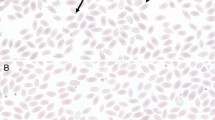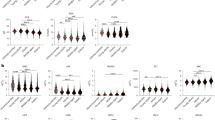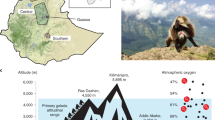Abstract
PROSIMIAN Primates are a group of animals which share characteristics of behaviour, anatomy, biochemistry, cytogenetics, and physiology with the monkeys on one hand and the more primitive Insectivora on the other1. We have been examining the hæmoglobins of a number of these animals. One of our most interesting discoveries is the relatively high level of alkali-resistant hæmoglobin found in these animals.
This is a preview of subscription content, access via your institution
Access options
Subscribe to this journal
Receive 51 print issues and online access
$199.00 per year
only $3.90 per issue
Buy this article
- Purchase on SpringerLink
- Instant access to full article PDF
Prices may be subject to local taxes which are calculated during checkout
Similar content being viewed by others
References
Andrew, R. J., Behavior (in the press).
Jonxis, J. H. P., and Huisman, T. H. J., Laboratory Manual on Abnormal Hæmoglobins (C. C. Thomas, Springfield, Illinois, 1958).
Singer, K., Chernoff, A. I., and Singer, L., Blood, 6, 413 (1951).
Sen, N. N., Das, K. C., and Aikat, B. K., Nature, 186, 977 (1960).
Poulik, M. D., Nature, 180, 1477 (1957).
Polyak, M., The Vertebrate Eye (University of Chicago Press, Chicago, Illinois, 1955).
Author information
Authors and Affiliations
Rights and permissions
About this article
Cite this article
BUETTNER-JANUSCH, J., TWICHELL, J. Alkali-resistant Hæmoglobins in Prosimian Primates. Nature 192, 669 (1961). https://doi.org/10.1038/192669a0
Issue date:
DOI: https://doi.org/10.1038/192669a0
This article is cited by
-
Mechanism of denaturation of haemoglobin by alkali
Nature (1974)
-
Hemoglobin variation in macaques
Primates (1970)
-
Haemoglobins of Adult and Foetal African Elephants
Nature (1965)
-
Plasma Proteins and Hæmoglobins of the African Elephant and the Hyrax
Nature (1964)
-
Hæmoglobins of Two Elephant Shrews
Nature (1963)



